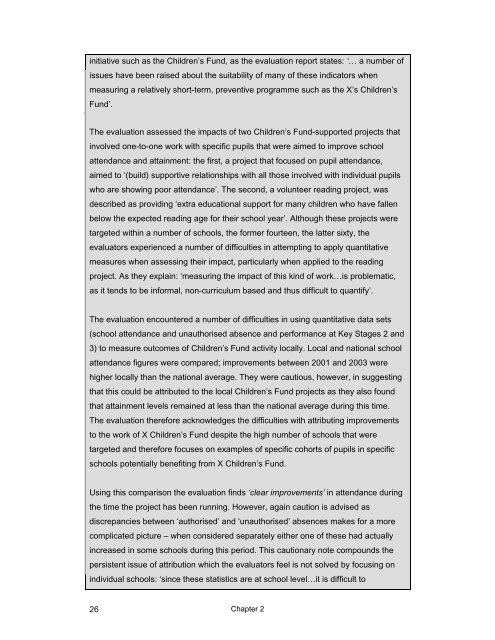Local Evaluation of Children's Services Learning from the Children's ...
Local Evaluation of Children's Services Learning from the Children's ...
Local Evaluation of Children's Services Learning from the Children's ...
- No tags were found...
Create successful ePaper yourself
Turn your PDF publications into a flip-book with our unique Google optimized e-Paper software.
initiative such as <strong>the</strong> Children’s Fund, as <strong>the</strong> evaluation report states: ‘… a number <strong>of</strong>issues have been raised about <strong>the</strong> suitability <strong>of</strong> many <strong>of</strong> <strong>the</strong>se indicators whenmeasuring a relatively short-term, preventive programme such as <strong>the</strong> X’s Children’sFund’.The evaluation assessed <strong>the</strong> impacts <strong>of</strong> two Children’s Fund-supported projects thatinvolved one-to-one work with specific pupils that were aimed to improve schoolattendance and attainment: <strong>the</strong> first, a project that focused on pupil attendance,aimed to ‘(build) supportive relationships with all those involved with individual pupilswho are showing poor attendance’. The second, a volunteer reading project, wasdescribed as providing ‘extra educational support for many children who have fallenbelow <strong>the</strong> expected reading age for <strong>the</strong>ir school year’. Although <strong>the</strong>se projects weretargeted within a number <strong>of</strong> schools, <strong>the</strong> former fourteen, <strong>the</strong> latter sixty, <strong>the</strong>evaluators experienced a number <strong>of</strong> difficulties in attempting to apply quantitativemeasures when assessing <strong>the</strong>ir impact, particularly when applied to <strong>the</strong> readingproject. As <strong>the</strong>y explain: ‘measuring <strong>the</strong> impact <strong>of</strong> this kind <strong>of</strong> work…is problematic,as it tends to be informal, non-curriculum based and thus difficult to quantify’.The evaluation encountered a number <strong>of</strong> difficulties in using quantitative data sets(school attendance and unauthorised absence and performance at Key Stages 2 and3) to measure outcomes <strong>of</strong> Children’s Fund activity locally. <strong>Local</strong> and national schoolattendance figures were compared; improvements between 2001 and 2003 werehigher locally than <strong>the</strong> national average. They were cautious, however, in suggestingthat this could be attributed to <strong>the</strong> local Children’s Fund projects as <strong>the</strong>y also foundthat attainment levels remained at less than <strong>the</strong> national average during this time.The evaluation <strong>the</strong>refore acknowledges <strong>the</strong> difficulties with attributing improvementsto <strong>the</strong> work <strong>of</strong> X Children’s Fund despite <strong>the</strong> high number <strong>of</strong> schools that weretargeted and <strong>the</strong>refore focuses on examples <strong>of</strong> specific cohorts <strong>of</strong> pupils in specificschools potentially benefiting <strong>from</strong> X Children’s Fund.Using this comparison <strong>the</strong> evaluation finds ‘clear improvements’ in attendance during<strong>the</strong> time <strong>the</strong> project has been running. However, again caution is advised asdiscrepancies between ‘authorised’ and ‘unauthorised’ absences makes for a morecomplicated picture – when considered separately ei<strong>the</strong>r one <strong>of</strong> <strong>the</strong>se had actuallyincreased in some schools during this period. This cautionary note compounds <strong>the</strong>persistent issue <strong>of</strong> attribution which <strong>the</strong> evaluators feel is not solved by focusing onindividual schools: ‘since <strong>the</strong>se statistics are at school level…it is difficult to26Chapter 2
















